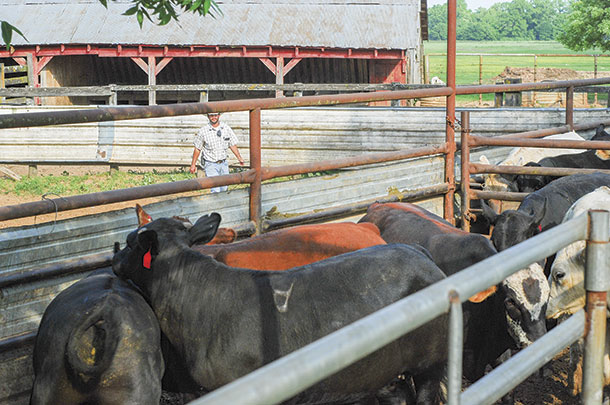“Farmers are nearly twice as likely to die on the job as police officers, five times as likely as firefighters, and 73 times as likely as Wall Street bankers.” And on top of that, “The Center for Disease Control and Prevention claims more farmers have been injured since 9/11 than U.S. soldiers.”
Several factors can contribute to injuries on cattle operations: Complacency, inattentiveness, carelessness, tiredness, poor working facilities or just bad luck – to name a few. Of these, there are a few things within our ability to control, one being the quality of our cattle-working facilities.
Ken Apple, an area livestock specialist at Oklahoma State University from 1967 until he retired in 1992, authored the corral plan book, “Modern Corral Design,” with extension engineers Sam Harp and Raymond L. Huhnke. Apple says, “Back in the early days, we were in desperate need of working corral systems.
I have seen corrals built out of junk cars, bedsprings, rock, everything. They would build a box and a lane, and work them out in the middle of that box. They had to beat the cattle to get them down the straight alley to the headgate. A lot of ranchers spent a lot of money on pipe and don’t have a workable system.”
Facilities that aren’t “up to snuff” increase the likelihood of injuries to cattle and producers alike. They reduce efficiency, require more hands to get the job done and create stress for the producer as well as the cattle.
Veterinarian Brent Hancock of Hobart, Oklahoma, says, “From a veterinarian’s perspective, if your working facilities aren’t adequate, it’s going to cost you a lot more money because it is going to take the veterinarian a lot more time.”
Know your hands
The most important consideration when looking at facilities is the primary users. Will there always be a crew of people on hand? Perhaps someone will have to sort out an individual animal and doctor it alone. Facilities should be designed so a person could do the work safely and single-handedly when necessary.
Briana Plyler wasn’t raised on a farm but jumped in with both feet when she married cattleman, Caleb Plyler – owner of Plyler and Son Charolais near Hope, Arkansas. They have a son, Huck, who’s 6 years old and helps chuteside with the cattle. Plyler says she learned everything she knows about cattle from her father-in-law, Harvey Plyler.
Plyler stresses the importance of good facilities. “I’m always getting cows, heifers and bulls up by myself. When we work the group, I’m usually the one pushing them up the alley into the chute. But when we draw blood for pregnancy testing, I run the headgate; you need a good squeeze chute,” she says.
It is important to the Plylers to have facilities safe enough for the oldest member of the family as well as the youngest. “Basically, contain the cattle, teach the child the rules and limits. Huck knows where to be and how best to help. He helps push cattle up the alley with his ‘Poppa Harvey.’”
Women are primary operators in 11 percent of beef businesses. The average age of cattle producers is 58. Consideration for physical limitations operators have is important. Building gates out of heavy-duty materials like bridge rails or heavy steel might make the job unnecessarily hard.
Daniel Rivera, Mississippi State University animal scientist says, “Producers need to consider availability and quality of labor. Are they able to hire people who know how to work cattle? Facilities need to be safe enough for people who haven’t been raised around cattle to work the animals without fear of catastrophic injuries.”
Jim Alford, a 60-year-old rancher in southwest Arkansas, has a 5,000-head stocker operation. “The thing I like about my little setup is I’ve got grandchildren coming up, and they like to be out there and I try to fix it to where they’re safe. What works good for a kid works good for an older person.”
Needs versus wants
The first step in designing new working facilities, or bringing existing facilities into the 21st century, is understanding the basics of herd instinct and animal behavior. Facility design should foster low-stress handling and maintain the safety of everyone involved.

There’s no shame in admitting a need for education when it comes to handling livestock. Even with a complete understanding of beef cattle behavior, accidents can happen; animals are unpredictable in stressful situations.
Essential components of cattle-working facilities include gathering and sorting pens, alleys, a squeeze chute with a headgate and a loadout chute. Well-designed facilities capitalize on cattle’s natural herding instinct and flight zone, incorporating their innate desire to turn in circles when stressed by incorporating a curved alley design.
The best setup would include a cover for shade when working cattle in inclement weather, scales and a palpation cage. Rivera says, “A producer who is just running them through once or twice a year may need a less sophisticated system than if they’re going to artificially inseminate or have a more complex operation.”
When planning or redesigning facilities, holding pens should allow 20 square feet per cow and 14 square feet per calf. Designing a facility large enough to accommodate your herd is essential; however, it is best to design in such a way as to make future expansion possible.
Whether you prefer a Bud box with a crowd gate or a sweep tub, the consensus is that cattle move through a system with solid sides better. Alleys should be adjustable so larger cattle can smoothly move through alleys without injury, and smaller cattle can be prevented from turning around.
The squeeze chute is also highly related to personal preference. It’s a good idea to try out several types, either at a neighbor’s place or at a dealership, to find the chute that is most comfortable for you to operate. Alford says, “I went to a hydraulic chute, it’s easier on everybody. The old shoulders get worn out.
“My working facilities are pretty much the way I want them. Early on, I was trying to rig them up the way I was raised; you’d have three or four sorting gates and a person on each gate. I never had more than one guy helping me for a long time, so we just put a crow’s-nest up and the two of us can sort four ways and it works great. Two people can do 500 to 600 head in an hour or so.”
Location, location, location
Access to the facilities by trucks is foremost in consideration of location. The facility should be accessible by trucks and trailers, even when the ground is wet. So attention to details such as wide gates and culverts, and plenty of gravel on the drive, as well as ample room for a semi to turn around is important.
The pens themselves need to be in a well-drained area. Fill and gravel may need to be hauled in to prevent muddy areas that can cause cattle to balk. Pens should be arranged in the pasture so that cattle can be easily driven from adjacent pastures into the pens.
In order for cattle-handling facilities to be “up to snuff,” you have to take into consideration how your operation works and who does the work on your operation. ![]()
PHOTO 1: Jim Alford’s hired hand helps a truck back up to his solid-sided loadout.
PHOTO 2: Cattle waiting to be loaded onto the truck at Jim Alford’s ranch. Photos by Melissa Beck.

-
Melissa Beck
- Freelance Writer
- Prescott, Arkansas
- Email Melissa Beck








